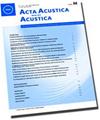用于水下无线传感器网络的球形压电换能器宽带振动能量采集
Q1 Arts and Humanities
引用次数: 3
摘要
提出了一种基于球形压电传感器的传感节点容器。该装置为水下无线传感器网络提供宽带振动能量收集和传感设施。该传感器由两个丙烯酸玻璃(PMMA)半球形外壳和夹在两个外壳之间的Pz26压电环组成。建立了基于厚度和径向振动模式的机电电路的振动能量收集仿真模型。通过有限元仿真验证了该方法的有效性。确定了最优的功率收集条件和估计的收集电压。实现了直径为2.2 cm的原型,并对其进行了表征。对空气环境的分析揭示了在20 - 80khz频率范围内的几种结构共振模式。用激光多普勒测振仪获得了这些模式对应的指向性图。在水下环境下的测量表明,结构共振模式的频率下降到10-60 kHz范围内,并表现出较低的指向性依赖性。相对于使用水听器进行的声压测量,测量和量化了能量收集性能。平均转换系数约为3 V/MPa。在宽频激励模式下,声压为10 kPa时,5种主要谐振模式的收获功率为3.3 μW。本文章由计算机程序翻译,如有差异,请以英文原文为准。
Broadband Vibrational Energy Harvesting with a Spherical Piezoelectric Transducer Devoted to Underwater Wireless Sensor Networks
A new sensing node container based on a spherical piezoelectric transducer is proposed. This device provides broadband vibrational energy harvesting and sensing facilities intended for underwater wireless sensor networks. The transducer is composed of two acrylic glass (PMMA) half-spherical
shells and a Pz26 piezoelectric ring clamped between the two shells. A simulation model of vibrational energy harvesting has been developed with electromechanical circuits for thickness and radial vibrational modes. This approach was validated by a finite element simulation. As a result, optimal
power harvesting conditions and estimated harvested voltage were defined. A prototype of 2.2 cm in diameter was realized and characterized. Analysis in air environment reveals several structural resonance modes in the 20–80 kHz frequency range. The directivity patterns corresponding
to these modes was obtained using laser Doppler vibrometry. The measurements for the underwater environment show that the structural resonance modes shift down in frequency to the 10–60 kHz range, and exhibiting low directivity dependence. Power harvesting performances was measured and
quantified relative to acoustical pres- sure measurements using a hydrophone. The average conversion coefficient value was found to be in the order of 3 V/MPa. In broadband excitation mode, and for an acoustic pressure of 10 kPa, the amount of harvested power out of 5 main resonance modes
is 3.3 μW.
求助全文
通过发布文献求助,成功后即可免费获取论文全文。
去求助
来源期刊
CiteScore
2.60
自引率
0.00%
发文量
0
审稿时长
6.8 months
期刊介绍:
Cessation. Acta Acustica united with Acustica (Acta Acust united Ac), was published together with the European Acoustics Association (EAA). It was an international, peer-reviewed journal on acoustics. It published original articles on all subjects in the field of acoustics, such as
• General Linear Acoustics, • Nonlinear Acoustics, Macrosonics, • Aeroacoustics, • Atmospheric Sound, • Underwater Sound, • Ultrasonics, • Physical Acoustics, • Structural Acoustics, • Noise Control, • Active Control, • Environmental Noise, • Building Acoustics, • Room Acoustics, • Acoustic Materials and Metamaterials, • Audio Signal Processing and Transducers, • Computational and Numerical Acoustics, • Hearing, Audiology and Psychoacoustics, • Speech,
• Musical Acoustics, • Virtual Acoustics, • Auditory Quality of Systems, • Animal Bioacoustics, • History of Acoustics.

 求助内容:
求助内容: 应助结果提醒方式:
应助结果提醒方式:


